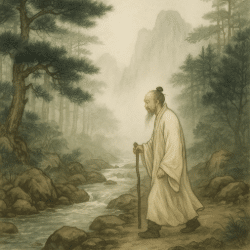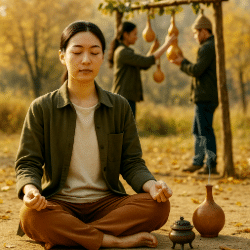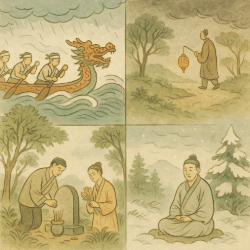In Taoism, nature is not a background. It is not merely scenery to admire or a resource to extract. Nature is the unspoken teacher, the great mirror of the Tao itself. The ancient sages did not invent their philosophy in towers of stone—they watched clouds. They followed rivers. They observed the stillness of cranes and the flexibility of bamboo. To live according to the Tao is to live as nature lives: without force, without striving, always in balance.
“Man follows the Earth. Earth follows Heaven. Heaven follows the Tao. The Tao follows what is natural.”
— Dao De Jing, Chapter 25
Stillness in the Forest: Taoist Lessons from Nature
The Tao is found in stillness. But this stillness is not stagnation—it is the quiet alertness of a cat under a tree, the hush of snowfall, the pause before dawn. In the forest, the Tao speaks through patterns. Trees do not hurry. Leaves do not struggle to fall. Everything occurs in its season. A Taoist practitioner, meditating beneath pine branches, does not seek to master their mind so much as match it to the quiet of the forest. In this way, nature becomes both the setting and the instructor of spiritual refinement.
“Be still like a mountain and flow like a great river.”
— Laozi, attributed saying
Earth and Sky: Taoism’s Symbols in Nature
Rocks are revered not for their hardness, but for their endurance. Water, often the core metaphor in Taoist thought, is praised not for force but for its yielding nature. The way water wears down stone is the way a wise person moves through life—subtle, patient, and inevitable.
“Nothing in the world is as soft and yielding as water. Yet for dissolving the hard and inflexible, nothing can surpass it.”
— Dao De Jing, Chapter 78
Wind and cloud represent transience. Mountains, permanence. Each has its place. Each expresses the Tao in form. Human beings, often arrogant in our distinctions, forget we are nature too. The more we remember this, the more ease we find in our lives.
Animals in Taoism: Observers, Teachers, Guides
Animals are not just companions in the Taoist view; they are sources of unfiltered wisdom. A fox crossing snow, a bird circling above the canyon, even an insect tracing light—these are acts without deception. Their behavior is neither self-conscious nor wasteful. Animals do not try to be themselves; they simply are.
Zhuangzi, one of Taoism’s great early writers, used animal parables to express Taoist truths. His stories of butterflies, fish, and flightless birds weren’t fantasy—they were mirrors held up to human folly. By watching animals, we are reminded how to return to our own natures.
“Once Zhuangzi dreamed he was a butterfly… He did not know if he was Zhuangzi who had dreamed of being a butterfly, or a butterfly dreaming he was Zhuangzi.”
— Zhuangzi, Chapter 2
The pigeon, though not traditionally highlighted in Taoist texts, is a modern example of unnoticed wisdom. In urban settings, pigeons adapt with incredible resourcefulness. They nest in concrete cracks, flow through pedestrian currents, and fly only when needed. There is no excess. No pretense. They offer a lesson in adaptation and unburdened presence for those willing to observe.
Walking the Mountain Path
To practice Taoism is to walk the mountain path, slowly, attentively. The ground beneath your feet is not symbolic of anything grand. It is simply earth. But to walk upon it with awareness is to learn something that cannot be spoken.
Seasons shift. Winds rise and fall. Nature teaches that change is not a crisis. It is the Tao in motion.
Taoist sages left few commandments. Instead, they offered images. A man sitting quietly beside a stream. A woman standing beneath falling plum blossoms. A crane flying over misted hills. The message is always the same: live gently, observe closely, and flow as nature flows.
Final Reflection
Taoism invites us to put down the sword of analysis and pick up the cup of observation. To walk in the forest is to enter sacred ground, not because it was ordained, but because it needs no ordaining. Its holiness lies in its plainness.
“All things arise from Tao. They are nourished by Virtue. They are formed from matter. They are shaped by environment.”
— Dao De Jing, Chapter 51
The Tao does not need explanation. It needs remembering. And nature, always waiting, always present, is the memory of the Tao made visible.
Frequently Asked Questions
In Taoism, nature is not separate from us. It is the expression of the Tao, a living demonstration of how to live in harmony, without force or resistance.
Animals act without pretense and follow their nature instinctively. Taoist sages observed animals to learn unforced living and the wisdom of simplicity.
Yes, but they are not limited to temples. Any place—forest, garden, or mountaintop—can be sacred if approached with presence and quiet observation.
While not framed as modern ecology, Taoism teaches deep respect and alignment with nature, encouraging minimal interference and attentive coexistence.
Further Articles Exploring Taoism and Nature
Trees in Taoism: Sacred Roots, Symbolism, and Practice Across Time and Tradition



